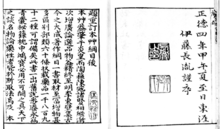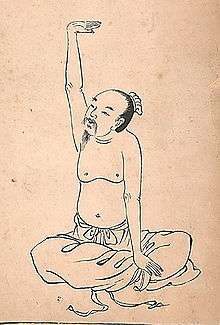Li Shizhen
| Li Shizhen 李時珍 | |
|---|---|
 An illustration of Li Shizhen | |
| Born |
July 3, 1518 Qizhou Town, Qichun County, Hubei |
| Died | 1593 (aged 74–75) |
| Other names | Dongbi (東璧) |
| Occupation | Polymath, physician, scientist, pharmacologist, herbalist, acupuncturist |
| Parent(s) |
|
| Li Shizhen | |||||||||
| Traditional Chinese | 李時珍 | ||||||||
|---|---|---|---|---|---|---|---|---|---|
| Simplified Chinese | 李时珍 | ||||||||
| |||||||||
Li Shizhen (July 3, 1518 – 1593), courtesy name Dongbi, was a Chinese polymath, physician, scientist, pharmacologist, herbalist and acupuncturist of the Ming dynasty. His major contribution to clinical medicine was his 27-year work, which is found in his scientific book Compendium of Materia Medica. He is also considered to be the greatest scientific naturalist of China, and developed many innovative methods for the proper classification of herb components and medications to be used for treating diseases.[1]
The Compendium is a medical text with 1,892 entries, with details about more than 1,800 drugs (Chinese Medicine), including 1,100 illustrations and 11,000 prescriptions. It also described the type, form, flavor, nature and application in disease treatments of 1,094 herbs. The book has been translated into many different languages, and remains as the premier reference work for herbal medicine.[1] The treatise included various related subjects such as botany, zoology, mineralogy, and metallurgy. The book was reprinted frequently and five of the original editions still exist.[2][1]
Biography

In addition to Compendium of Materia Medica, Li wrote eleven other books,[3] including Binhu Maixue (Pin-hu Mai-hsueh; Chinese: 《瀕湖脈學》; "A Study of the Pulse") and Qijing Bamai Kao (Chi-ching Pa-mai Kao; Chinese: 《奇經八脈考》; "An Examination of the Eight Extra Meridians").[4] He lived during the Ming Dynasty and was influenced by the Neo-Confucian beliefs of the time. He was born in what is today Qizhou,[5] Qichun County, Hubei in July 3, 1518 AD and died 75 years later, in 1593.[3]
Li's grandfather had been a doctor who traveled the countryside and was considered relatively low on the social scale of the time. His father was a traditional physician and scholar who had written several influential books. He tried to move up in society and encouraged his son to seek a government position. Li took the national civil service exam three times, but after failing each one, he turned to medicine. At 78, his father took him on as an apprentice. When he was 38, and a practicing physician, he cured the son of the Prince of Chu and was invited to be an official there. A few years after, he got a government position as assistant president at the Imperial Medical Institute in Beijing. However, even though he had climbed up the social ladder, as his father had originally wanted, he left a year later to return to being a doctor.[3]
In his government position, Li was able to read many rare medical books; he also saw the disorder, mistakes, and conflicting information that were serious problems in most medical publications of the time and soon began the book Compendium of Materia Medica to compile correct information with a logical system of organization.[1] A small part was based on another book which had been written several hundred years earlier, Jingshi Zhenglei Beiji Bencao (Ching-hsih Cheng-lei Pei-chi Pen-tsao; "Classified Materia Medica for Emergencies") – which, unlike many other books, had formulas and recipes for most of the entries. In the writing of the Compendium of Materia Medica, he travelled extensively, gaining first-hand experience with many herbs and local remedies and consulted over 800 books – nearly every medical book in print at the time.[3]
Altogether, the writing of Compendium of Materia Medica took 27 years, which included three revisions. Ironically, writing the book allegedly took a considerable toll on his health.[3] It was rumored that he stayed indoors for ten consecutive years during the writing of the Compendium of Materia Medica.[6] After he had completed it, a friend “reported that Li was emaciated.”[3]
Li died before the book was officially published, and the current emperor paid it little regard.[3] However, it remained one of the most important materia medica of China.
Compendium of Materia Medica

Compendium of Materia Medica was a massive literary undertaking. Li's bibliography included nearly 900 books. Because of its size, it was not easy to use, though it was organized much more clearly than others that had come before,[3] which had classified herbs only according to strength. He broke them down to animal, mineral, and plant and divided those categories by their source. Dr. S. Y. Tan[6] says: “his plants were classified according to the habitat, such as aquatic or rock origins, or by special characteristics, e.g. all sweet-smelling plants were grouped together.”[6]
Li had exemplary recording techniques. Seeking to fix the errors of previous works, the medicinal plants and substances in the Compendium of Materia Medica were clearly organized and categorized. With every entry, he included:
- “Information concerning a previously false classification;
- Information on secondary names, including the sources of the names;
- Collected explanations, commentaries and quotes in chronological order, including origin of the material, appearance, time of collection, medicinally useful parts, similarities with other medicinal materials;
- Information concerning the preparation of the material;
- Explanation of doubtful points;
- Correction of mistakes;
- Taste and nature;
- Enumeration of main indications;
- Explanation of the effects; and
- Enumeration of prescriptions in which the material is used, including form and dosage of the prescriptions.”[3]
Compendium of Materia Medica contained nearly 1,900 substances, which included 374 that had not appeared in other works. Not only did it list and describe the substances, but it also included prescriptions for use – about 11,000 - 8,000 of which were not well known.[3] The Compendium of Materia Medica also had 1160 illustrated drawings to aid the text.[4]
In addition to writing Compendium of Materia Medica, Li was one of the first to recognize gallstones, use ice to bring down a fever, and to use steam and fumigants to prevent the spread of infection. Li also emphasized preventative medicine.[6] He said that “‘To cure disease is like waiting until one is thirsty before digging a well...’” and listed over 500 treatments to maintain good health and strengthen the body, 50 of which he invented himself.[4]
Compendium of Materia Medica still has scientific, medical, and historical significance today. A plant or substance’s inclusion in the Compendium of Materia Medica is a sign of posterity. Medical clinics and manufacturers use his name and image on their logos and products and there was even a movie made about his life in 1956. His image can be found at almost every traditional medical college in China and in many books about Chinese medicine. There is even a Li Shizhen award for “doctors and researchers who have made valuable contributions to traditional Chinese medicine.”[3]
While only six copies of the original edition remain – One in the US Library of Congress, two in China, and three in Japan (a seventh copy in Berlin was destroyed during World War II)[6] – several new editions and numerous translations have been made throughout the centuries, and it was not replaced as the pharmaceutical materia medica of China until 1959: over 400 years after its first publication.[3]
See also
Notes
- 1 2 3 4 "《走遍中国》 20111105 医药双圣李时珍_《医药双圣李时珍》_视频_央视网". tv.cntv.cn. Retrieved 2018-05-21. CNTV Documentary on the life and achievements of Li Shizhen, with focus on his work Compendium of Materia Medica. Title is 《医药双圣李时珍》 (English translation is "Medical and Pharmacological Sage Lishizhen"). Part of the series 《走遍中国》 (English name is "Around China"). English subtitles are available.
- ↑ Original text from Li Shizhen, licensed under the GNU Free Documentation License.
- 1 2 3 4 5 6 7 8 9 10 11 12 Dharmananda, Subhuti. "Li Shizhen: Scholar Worthy of Emulation." Institute for Traditional Medicine. Institute for Traditional Medicine. 25 Apr. 2006 <http://www.itmonline.org/arts/lishizhen.htm>.
- 1 2 3 "The Herbal Tradition." PlanetHerbs.Com. 2005. 24 Apr. 2006 <http://www.planetherbs.com/articles/herbhist.html>.
- ↑ Panyu Tiger: Li Shizhen 李時珍
- 1 2 3 4 5 Tan, S Y. "Medicine in Stamps -- Li Shih-Chen (1518-1593) -- Herbalist of Renown." Singapore Medical Association. 2003. University of Hawaii. 24 Apr. 2006 <http://www.sma.org.sg/smj/4407/4407ms1.pdf>.
References
| Wikimedia Commons has media related to Li Shizhen. |
- Wang, Zichun, "Li Shizhen". Encyclopedia of China (Biology Edition), 1st ed.
- "Classics of Traditional Chinese Medicine." National Library of Medicine. 12 Jan. 2005. National Library of Medicine, National Institute of Health. 24 Apr. 2006 <https://www.nlm.nih.gov/hmd/chinese/chinesehome.html>.
- "Tufts EBCAM." Tufts University. 09 Feb. 2006. Tufts University Medical School, New England School of Acupuncture. 24 Apr. 2006 <https://web.archive.org/web/20060415090909/http://www.tufts.edu/med/ebcam/eastAsianMed/transmissionThought2.html>.
